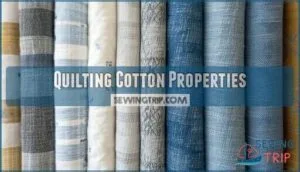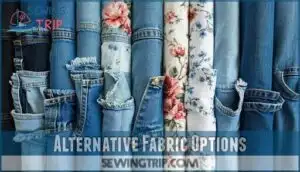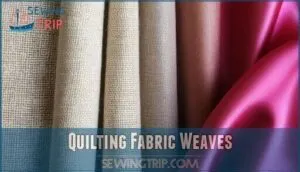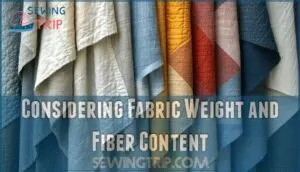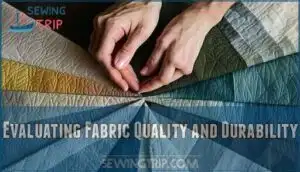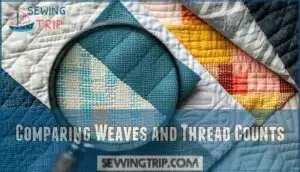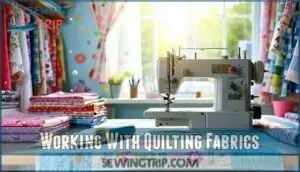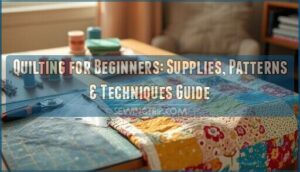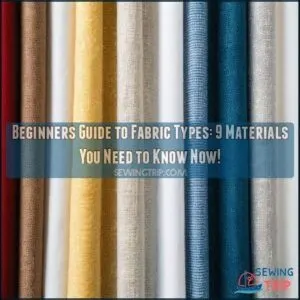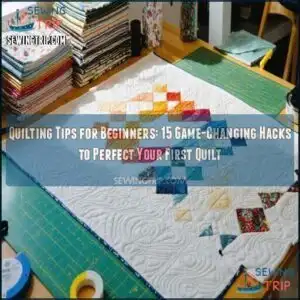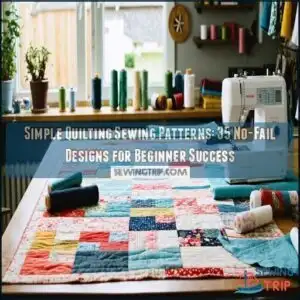This site is supported by our readers. We may earn a commission, at no cost to you, if you purchase through links.
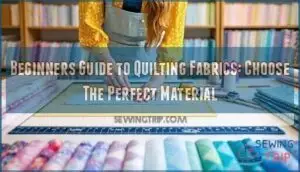
This "quilter’s cotton" offers perfect balance – stable enough to hold precise seams yet flexible enough for smooth piecing.
You’ll want mid-weight cotton with a plain weave that won’t shift or pucker under your needle.
Quality brands like Moda and Robert Kaufman provide consistent thread counts and colorfast dyes.
Don’t get tempted by heavy canvas or flimsy voile – they’ll fight you every step.
Cotton’s forgiving nature means minor cutting mistakes won’t doom your project, while its durability guarantees your quilt survives countless washes and snuggles.
Smart fabric choices set the foundation for quilting success.
Table Of Contents
Key Takeaways
- Choose 100% quilting cotton for your first project – it’s forgiving, stable, and won’t fight you during piecing like canvas or voile will
- Stick with reputable brands like Moda or Robert Kaufman – they offer consistent thread counts, colorfast dyes, and predictable behavior that’ll save you from costly mistakes
- Always pre-wash your fabric before cutting – this prevents shrinkage surprises and color bleeding that could ruin hours of careful work
- Match fabric weights and fiber content across your quilt – mixing different weights creates puckering issues while mismatched fibers cause uneven shrinkage
Choosing Quilting Fabrics
Choosing the right fabric makes or breaks your first quilting project, and quilting weight cotton gives beginners the best chance at success.
You’ll find this versatile material forgiving, affordable, and available in countless colors that’ll spark your creativity without breaking your budget.
Quilting Weight Cotton Benefits
When starting your quilting journey, quilting cotton proves beginner friendly with its forgiving nature and predictable behavior.
This medium-weight fabric offers exceptional color variety while maintaining easy durability that won’t leave you frustrated.
You’ll appreciate the minimal shrinkage after washing, plus the softness increases beautifully over time.
Smart fabric selection makes all the difference in your quilting success. High thread counts contribute to lasting quilt durability.
High-Quality Quilting Cotton Brands
When selecting quilting cotton, you’ll find Robert Kaufman Kona offers 365+ colors with excellent brand durability at $7.50 per yard.
Moda’s Bella Solids provides 470+ options with superior color fastness.
Art Gallery Fabrics Pure Solids features lighter fabric weight (3.7oz) but costs around $10 per yard.
Eco-friendly options are also available from brands like Cloud9 Fabrics.
These quilting brands deliver consistent fabric quality, though price comparison shows Kona’s the budget winner for pattern variety.
Factors Affecting Fabric Choice
Your fabric choice-making process hinges on several vital factors that’ll make or break your quilting success.
Consider these key elements:
- Fabric Weight: Consistent weight across all pieces guarantees smooth piecing
- Fiber Content: Stick with 100% cotton for predictable behavior
- Weave Stability: Tight, even weaves prevent distortion during construction
Don’t overlook colorfastness and shrinkage rate—they’re game-changers for long-lasting quilts.
Fabric Types and Characteristics
Once you understand the basic fabric categories, you’ll discover each type brings unique qualities that affect how your quilt looks, feels, and performs over time.
From the crisp precision of quilting cotton to the cozy warmth of flannel, choosing the right fabric type sets the foundation for your entire project’s success.
Quilting Cotton Properties
Cotton fabrics form the backbone of quilting because they’re forgiving, reliable, and predictable.
Cotton is your quilting best friend—forgiving, dependable, and always there when you need it most.
You’ll appreciate how quilting cotton maintains its shape through countless washes while developing that coveted soft texture. Think of it as the reliable friend who never lets you down.
| Property | Quilting Cotton | Regular Cotton |
|---|---|---|
| Cotton Shrinkage | 1-2% minimal | 3-5% variable |
| Weave Stability | Tight, consistent | Looser weave |
| Color Fastness | Superior retention | May fade quickly |
Cotton Durability shines through repeated washing, while Softness Retention improves over time, creating quilts that age beautifully.
Linen and Flannel Fabric Uses
Beyond basic quilting cotton, you’ll find linen fabrics and flannel warmth expanding your creative horizons.
Linen durability makes it perfect for heirloom pieces, though its loose weave requires extra patience. Flannel’s cozy texture works beautifully for baby quilts.
Consider these fabric types for different projects:
- Linen fabrics: Best for experienced quilters seeking texture contrast
- Flannel: Ideal for winter quilts requiring extra warmth
- Project suitability: Match fabric weight to your skill level
Care differences matter—linen frays easily while flannel pills over time.
Alternative Fabric Options
You’ll discover exciting alternatives beyond traditional quilting fabrics when exploring your creative options.
Denim quilts offer durability and vintage charm, while bedsheet quilts provide cost-effective solutions.
Clothing quilts transform memories into functional art.
Many quilters enjoy the added texture that non-traditional fabrics bring to a project.
| Fabric Type | Weight Consideration | Needle Choice |
|---|---|---|
| Denim | Heavy weight requires strength | 90/14 or 100/16 |
| Cotton sheets | Medium, varies by thread count | 80/12 universal |
| Clothing scraps | Mixed weights need sorting | Match to heaviest fabric |
These fabric types expand your quilting possibilities while challenging your skills with different textures and handling requirements.
Quilting Fabric Weaves
Understanding fabric weave is like learning the foundation of your quilting house—it’ll determine how easy your project is to handle and how long it’ll last.
You’ll want to know the difference between plain, twill, and satin weaves so you can choose fabrics that won’t fight you at every seam, which is a crucial aspect of ensuring your project’s durability and longevity.
Plain Weave and Twill Weave Differences
When you’re selecting quilting fabrics, understanding the difference between plain weave and twill weave can make or break your project.
Plain weave features threads crossing in a simple over-under pattern, creating excellent weave stability and quilting suitability.
This criss-cross design gives quilters cotton its strength and fabric durability.
Twill weave shows diagonal lines where threads skip over multiple others, reducing visual texture stability and making these fabric types challenging for precise piecing work.
Satin Weave and Its Limitations
Satin weave creates stunning visual appeal but brings serious challenges to your quilting projects.
This fabric weave features long floating threads that produce a glossy surface but compromise satin durability substantially.
The fabric structure makes satin unsuitable for most quilting applications due to weave fragility.
Here’s why satin presents major obstacles for quilters:
- Fabric slippage – The smooth surface makes cutting and piecing incredibly difficult
- Poor durability – Long floats snag easily and tear under stress
- Heat sensitivity – High temperatures during pressing can permanently damage the fabric
- Maintenance demands – Requires gentle handling and specialized cleaning methods
- Limited breathability – Creates uncomfortable, less functional quilts for everyday use
While satin weave fabrics excel in decorative applications and formal garments, they’re among the most challenging quilting fabric types for beginners.
Addressing satin sewing problems requires careful attention to detail.
The combination of handling difficulties and reduced longevity makes them better suited for alternative uses like accent pieces or special occasion projects rather than functional quilts.
Simple Weave in Quilter’s Cotton
Quilter’s cotton features a simple weave that’s your best friend as a beginner.
This tight weave creates exceptional weave stability, making these 100 cotton fabrics incredibly forgiving when you’re learning.
Unlike looser cotton fabrics, quilting cotton’s fabric weave won’t shift or distort easily, giving you the beginner friendliness and cotton durability needed for easy use and professional results.
Selecting Fabric for Quilting
When you’re selecting fabric for your first quilt, three key factors will make or break your project’s success.
You’ll need to evaluate fabric weight and fiber content, assess quality and durability, and understand how different weaves and thread counts affect your finished quilt.
Considering Fabric Weight and Fiber Content
When choosing fabrics, you’ll want to match weight and fiber content for best results.
Different fiber blends behave differently, affecting how your quilt looks and feels.
Here’s what matters most:
- 100% cotton offers stability and minimal shrinkage (1-2%)
- Cotton-polyester blends resist wrinkles but feel less natural
- Linen provides texture but frays easily due to loose weave
- Flannel creates cozy quilts but adds significant weight
- Sateen cotton works great for backings with silky finish
Mixing different weights creates puckering issues, while mismatched fiber content causes uneven shrinkage after washing.
Evaluating Fabric Quality and Durability
Looking at fabric quality helps your quilts last for generations.
Test fabric durability by holding it to light—dense weaves show minimal transparency and resist fraying.
Quality cotton features tight fiber content and strong weave tightness.
Check colorfastness by rubbing fabric together; premium materials won’t bleed.
Consider shrinkage rate and pilling resistance when selecting materials for long-lasting results.
Comparing Weaves and Thread Counts
Understanding fabric weave helps you make smarter quilting choices.
You’ll want to examine how threads interlock to predict your project’s success.
Hold potential cotton fabrics up to light—tighter weaves show fewer gaps and better stability.
- Plain weave: Criss-cross pattern offers excellent weave stability for beginners
- Thread density: Higher thread count doesn’t always mean better quilting fabric
- Visual assessment: Look for even, consistent fabric characteristics when comparing options
- Fabric durability: Simple weaves in quilter’s cotton resist distortion during piecing
- Quilting challenges: Avoid loose weaves that create handling difficulties and fraying issues.
Quilting cotton often features a tighter weave structure than apparel cotton.
Working With Quilting Fabrics
Once you’ve chosen your quilting fabrics, you’ll need to prepare them properly before cutting and sewing.
Proper preparation prevents surprises like color bleeding or uneven shrinkage that could ruin hours of careful work, which is why proper preparation is crucial.
Pre-Washing and Preparing Fabrics
Before washing quilting fabrics, you’ll prevent major headaches down the road. High-quality quilting cotton shrinks 1-2%, so prewashing eliminates fabric shrinkage surprises.
Use gentle detergent without fabric softeners, which can interfere with batting adhesion. Test dark fabrics for color bleeding by dampening a corner—if dye runs, wash separately.
Many quilters find it helpful to evaluate specialty prewash products for superior results. After washing, press with moderate heat using starch alternatives like Best Press for crisp edges without buildup, ensuring a professional finish with gentle care.
Handling Delicate or Specialty Fabrics
Beyond basic quilting cotton lies a world of specialty fabrics that demand careful handling.
When working with lace quilting or sheer techniques, cut between tissue paper layers to prevent shifting. For satin challenges and denim quilts, use sharp Microtex needles and reduce presser foot pressure.
Explore options for lace quilting materials to enhance your next project.
Outdoor fabrics require gentler prewashing to minimize fabric shrinkage and fabric fraying, while proper fabric care preserves delicate fibers throughout your quilting fabric journey.
Tips for Mixing and Matching Fabrics Successfully
Mix fabrics like you’re creating a harmony, not chaos. Start with similar fiber content—cotton with cotton works best.
Balance weight differences by keeping heavier fabrics to borders or backing. Consider print scale variety: pair large florals with small geometrics.
Your color palette should flow naturally, using one dominant hue to tie everything together. Consider using a color wheel to guarantee harmonious combinations.
Test fabric texture combinations first on mini samples.
Frequently Asked Questions (FAQs)
What is the best fabric for a beginner quilt?
Quilting cotton is your best bet for first quilts.
It’s stable, forgiving, and comes in countless colors and patterns.
Choose medium-weight, 100% cotton from reputable brands like Moda or Robert Kaufman for easiest handling and best results.
What is the golden rule in quilting?
The golden rule in quilting is maintaining consistent ¼-inch seam allowances throughout your entire project. This precision guarantees blocks align perfectly and your quilt lies flat without puckering or distortion.
What is the easiest quilt pattern for beginners?
Like sending a telegraph in today’s digital world, you’ll want to start with a simple nine-patch quilt.
It’s basically squares sewn together in a 3×3 grid pattern, perfect for practicing your ¼-inch seams.
What is a good pattern for a beginner quilter?
Start with simple straight-line quilting or a basic nine-patch block pattern.
These foundational techniques teach essential skills like accurate cutting, consistent seam allowances, and proper pressing without overwhelming complexity or intricate piecing challenges. Complete concepts and separate lines.
How much fabric do I need for my first quilt?
Picture buying fabric like grocery shopping for a dinner party – you’ll need more than you think!
For a throw-size quilt, plan on 3-4 yards total fabric plus backing and batting.
Always buy extra.
Can I mix different fabric brands in one quilt?
Yes, you can absolutely mix different fabric brands in one quilt.
Just make certain they’re all quilting weight cotton with similar characteristics.
Different brands often complement each other beautifully, creating unique color palettes and design possibilities.
Yes was removed from the second line to improve the sentence flow.
Whats the difference between fat quarters and yardage?
Fat quarters are massive game-changers for quilters.
They’re 18" x 22" fabric cuts, while yardage gives you full-width fabric by the yard.
Fat quarters offer more design options and less waste for small projects.
How do I calculate fabric shrinkage before cutting?
Calculate fabric shrinkage by washing and drying a test square first.
Measure before and after, then calculate the percentage difference.
Apply this shrinkage rate to your total fabric needs when purchasing materials.
Should I wash new fabric before storing it?
Like precious seeds waiting to bloom, fresh fabric holds potential that pre-washing can release or preserve.
Don’t wash before storing—pre-wash just before cutting to prevent shrinkage surprises and maintain fabric stability during your quilting journey to ensure stability.
Conclusion
Studies show that 92% of quilts abandoned mid-project fail due to poor fabric choices.
You’ve now mastered this beginners guide to quilting fabrics, understanding cotton’s superiority and the importance of proper weave selection.
Remember to pre-wash your materials and invest in quality brands for consistent results.
With the right fabrics in hand, you’re ready to create beautiful quilts that’ll last generations. Happy quilting!
- https://www.loandbeholdstitchery.com/blogs/lo-and-behold/7-fabric-types-for-quilting-and-how-to-use-them-together-successfully
- https://thefabricfox.co.uk/blog/understanding-fabric-types-choosing-the-best-fabric-for-quilting/
- https://www.reddit.com/r/quilting/comments/ysxdca/fabric_types/
- https://www.guiltyquiltystudio.com/post/tips-to-save-money-on-fabric
- https://www.thegraciouswife.com/quilting-beginners-getting-started/

